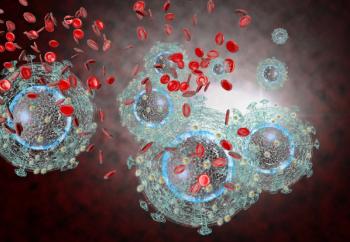
Are We Winning or Losing the HIV Prevention Initiative in the US?
Despite gains, the sobering reality is that HIV transmission-- primarily via sexual means--continues at an unacceptably high rate in the United States.
Much has been made of the success of combination antiretroviral therapy (cART) in durably suppressing HIV replication to levels that are “undetectable” in the blood. As a result, life expectancy of an HIV-infected person on antiretroviral therapy in North America in his or her mid-twenties approximates that of an HIV-negative individual of similar age. This outcome often is referred to as a “functional cure” of HIV. True eradication of HIV-- at least on a large scale level--is still years or even decades away. In addition, we do not yet have an effective vaccination against HIV, and not everyone with HIV is on cART or even in care. Consequently, transmission of HIV continues, and prevention of transmission should be a high priority throughout North America.
So, how are we doing?
Results, while encouraging, are decidedly mixed. In the United States, the CDC advocated years ago that states change informed consent laws for testing for HIV to incorporate such testing into routine care. The CDC recommended an “opt out” model, which basically means that a health care provider allows a patient an opportunity to refuse an HIV test, but is not required to obtain true informed consent. Most states, with a few notable exceptions (including my own state of Michigan), have moved in this direction. The result has been an increase in the number of persons getting tested for HIV, as well as earlier detection of HIV in many cases. Earlier detection of HIV is important, as it often results in getting an HIV-infected person onto antiretroviral therapy earlier and sometimes results in substantial modification of risk behavior. Antiretroviral therapy, used in this setting, often is referred to as “treatment as prevention”; an HIV-infected person on cART with an HIV RNA level <200 copies/mL, has an approximately 0% chance of transmitting the virus sexually, even in the absence of safe sex precautions.
What has not had any documented effect on reducing the transmission of HIV are laws that criminalize or stigmatize some aspect of HIV infection. For instance, as of 2011, 33 states had enacted a total of 67 laws requiring disclosure of HIV status to sexual partners and/or needle-sharing partners, or criminalizing behaviors that pose almost zero risk for HIV transmission.1 In addition, at least one medical school, the Georgia Regents University in Augusta, Georgia, requires all health sciences students admitted after January 2013 to undergo mandatory testing for HCV and HIV. Not only is such a policy punitive and misguided, it will have no effect on reducing the number of HIV transmissions in the United States, nor do anything to increase the safety of patients hospitalized at the University’s Health Center. For instance, in the late 1980s, two states, Illinois and Louisiana, passed and enforced laws requiring that couples obtain HIV testing prior to getting a marriage license. The Louisiana law was repealed 7 months after it went into effect; the Illinois law was repealed 20 months after it went into effect. Reasons for repeal included potential 4th (unreasonable search and seizure) and 14th (equal protection) Amendment violation concerns, privacy concerns, poor utilization of state resources, and ineffectual outcome. During the entire time that the Illinois law was in effect, only 0.02% of those tested (1 in 5000) were found to be HIV-infected. At the same time, there was a noticeable decrease in the number of marriage licenses issues by the State of Illinois, and a noticeable increase in the number of marriage licenses issued by the adjoining state of Wisconsin.
The Infectious Diseases Society of America (IDSA) and HIV Medical Association (HIVMA), both of which include me as a member, are finalizing a joint position statement that opposes such laws and punitive approaches.
Recently, the CDC published data showing that HIV diagnoses in the United States declined 33% from 2002 – 2011, despite the increased testing that occurred during this period.2 Declines were seen in “nearly every” demographic group: the largest drops were seen in women, those aged 35 – 44 years, and persons of multiple races.
Unfortunately, there was no drop in the number of diagnoses attributed to male-to-male transmission (MSM), and there was a more than doubling (133% increase) in the number of diagnoses made in the 13 – 24 year age group among MSMs. This age and risk behavior cohort (young MSMs) has been the focus of intense study, as MSM transmission networks have been found to be a major contributor to the ongoing HIV transmission epidemic in the US and other countries around the world. A recent CDC-funded study in North Carolina found that HIV-negative and HIV-infected black MSM often were part of the same sexual network, and suggests that more frequent partner referrals for testing and counseling might help reduce transmission rates within these networks.3 Previous studies have shown that black MSM have risk behaviors similar to MSM of other races and ethnicities,4 but are more likely to have an HIV exposure within their sexual network.5
Finally, another recent study looked at attitudes among black MSM concerning talking with peers about HIV testing.6 Although 85% of participants felt that it was important or very important to talk to male friends about HIV transmission risks, fewer than 15% reported having been talked to within their social network about HIV
The Bottom Line
In summary, MSMs accounted for over 60% of the almost 50,000 new diagnoses of HIV in the US in 2011, the last year for which data are available.7 During that same year, persons aged 13 – 24 years accounted for over 20% of all infections in the US,7 and male and female blacks of all ages accounted for 47% of all infections in the US. These data, along with the data discussed above, suggest that young black MSM are at the intersection of these cohorts, and provide a willing group for counseling, risk prevention interventions, and testing. Whether the individual state public health agencies and clinics have the resources, will, and expertise to intervene is an entirely different question that I will attempt to answer next month.
For now, the sobering reality is that HIV transmission, primarily through sexual means, continues at an unacceptably high rate in the United States. We are in urgent need of effective interventions and ways of facilitating better access to care and earlier entry into the health system among groups at high risk of HIV transmission and infection.
References:
- Lehman JS, Carr MH, Nichol AJ, et al for the Centers for Disease Control and Prevention (CDC). Prevalence and public health implications of state laws that criminalize potential HIV exposure in the United States.
Aids & Behavior. Published online March 15, 2014. - Satcher Johnson A, Hall HI, Hu X, et al. Trends in diagnoses of HIV infection in the United States, 2002-2011. JAMA. 2014;312:432-434.
- Peters PJ, Gay C, Beagle S, et al. HIV infection among partners of HIV-infected black men who have sex with men-North Carolina, 2011-2013. MMWR. 2014;63:90-94.
- Millett GA, Flores SA, Peterson JL, et al. Explaining disparities in HIV infection among black and white men who have sex with men: a meta-analysis of HIV risk behaviors. AIDS. 2007;21:2083-2091.
- Hurt CB, Beagle S, Leone PA, et al. Investigating a sexual network of black men who have sex with men: implications for transmission and prevention of HIV infection in the United States. J Acquir Immune Defic Syndr. 2012;61:515-521.
- Tobin KE, Yang C, Sun C, et al. Discrepancies between HIV prevention communication attitudes and actual conversations about HIV testing within social and sexual networks of African American men who have sex with men. Sex Transm Dis. 2014;41:221-226.
- Centers for Disease Control and Prevention.
HIV Surveillance Report, 2011 ; volume 23. Published February 2013.
Newsletter
Enhance your clinical practice with the Patient Care newsletter, offering the latest evidence-based guidelines, diagnostic insights, and treatment strategies for primary care physicians.




















































































































































































































































































